© 2020 Service Design Academy
Made with ❤ by mtc.
INDUSTRY* Education, Third Sector, Health, Wellbeing and Sports.
The Challenge: The Wood Foundation wanted to support the creation of a new framework for community led projects which connect, engage and support young people in new ways through sport.
The Approach: A service design learning programme covering user research methods, ideation, prototyping, and implementation support built skills and capabilities to identify the needs of young people and radically re-think provision to co-design innovative new projects.
The Outcome: One charity re-designed their service provision, business planning & operations. Service Design provided space, process & an opportunity to reflect, reset and refocus on providing high quality support for young people in some of the worst areas of deprivation in Scotland.
The Impact: Pilot programmes included initiatives that enabled young people to connect with sport by providing appropriate clothing, mental health support, food education, young leaders, and work experience programmes, broadening the scope of support and the ages of young people involved.
Re-imagining funding and support opportunities
The Wood Foundation (TWF) has offered strong financial support for many years to the health, fitness, and wellbeing of young people in Aberdeen. Just one example is the Russell Anderson Development School (RADS). RADS provides quality fitness and health coaching to young people aged 4 -11 in one of Aberdeen’s most deprived areas. As well as increasing opportunities for exercise and encouraging healthy lifestyles, the coaching programme supports communication, social and life skills.
TWF recognised the opportunity for its support to evolve towards the development of more innovative and sustainable projects to meet the challenge of improving the health and wellbeing of young people in the community.
TWF wanted to develop and support a new framework of community- led projects that concentrates on what communities need, rather than dictating where funds will go or asking organisations to bid against each other for funding. They envisaged enabling collaboration and connection across the city for the benefit of young people.
By building the skills sets and capabilities of health and wellbeing partner organisations to fully meet the needs of young people in their communities, it is hoped that the partner organisations will collaborate, as well as involving their communities and team, on the co-design of new and innovative project proposals. Critically, they should build resilience through discovering new sources of sustainable income.
The Service Design Learning Experience
The Service Design Academy (SDA) worked with TWF to identify a shared problem statement, to connect partner organisations while learning the service design process. Five full days of interactive, engaging and impactful sessions were delivered online, for delegates, alongside representatives from TWF.
The sessions were designed to fully engage delegates with group work to encourage shared thinking and collaborative working. Service design principles influenced the workshop design positively with an equitable approach – all voices must be heard. The activities promoted group and independent discovery.
“How might we work together to remove barriers for young people and co-create new, exciting, and innovative ways to positively challenge sport, health and wellbeing in Aberdeen?”

Embracing the learning for success
The process was much more than just training, it enabled delegates to practice service design tools on organisational problems, ideate solutions, develop, and test their ideas in an atmosphere that was conducive to collaboration rather than competition. RADS have
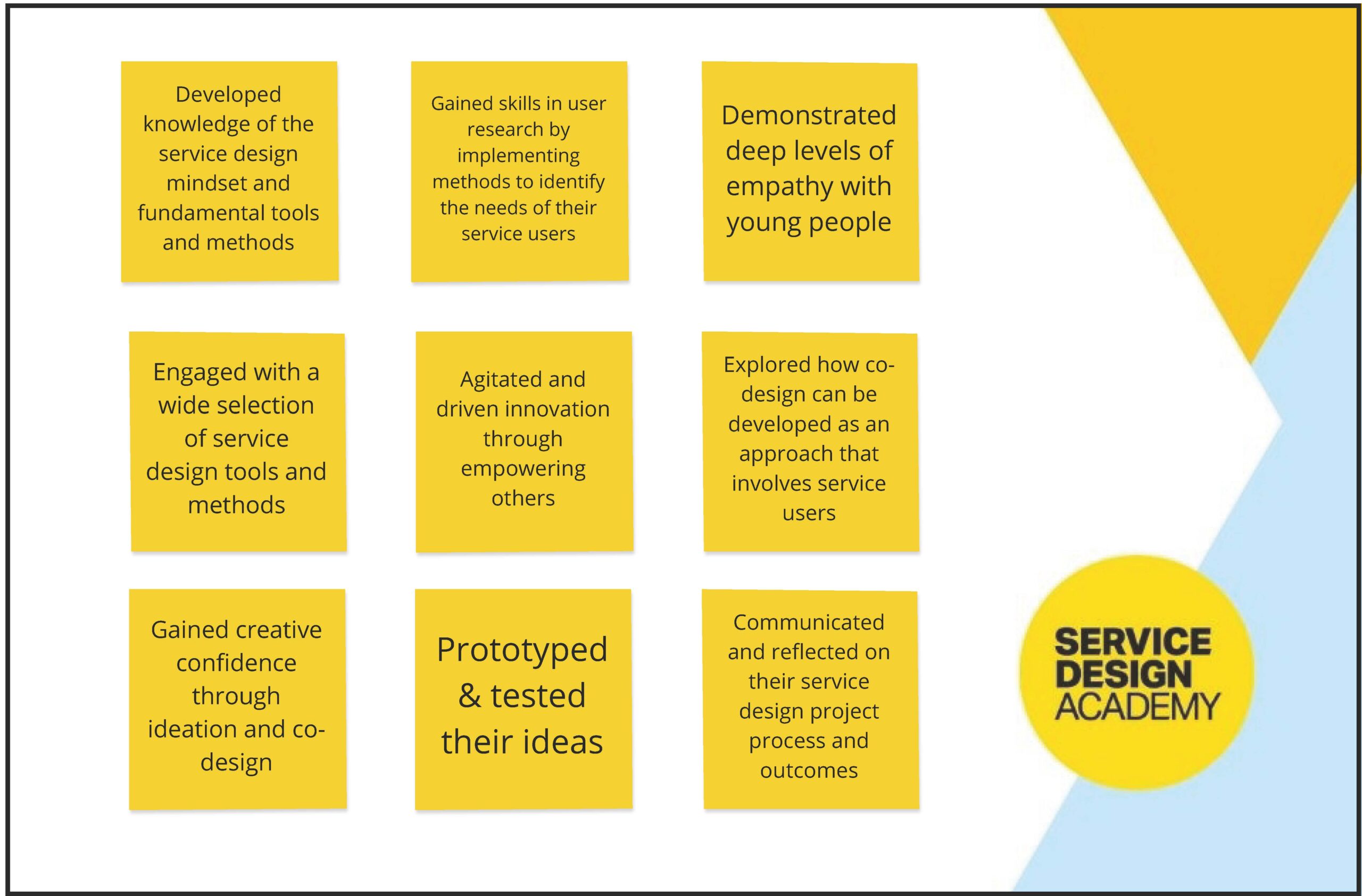
To support partner organisations SDA hosted individual data analysis and reflection meet-ups 4 weeks after the workshops. These allowed organisations to reflect on their time with SDA and start to formulate plans and proposals for funding to present and share.
This was an integral part of the process, that enabled SDA to identify where additional support was needed but also to gain invaluable feedback on delivery approaches, learning materials and facilitation
Service Design Outputs and Outcomes at RADS
RADS had taken the opportunity to stop, reflect and re-design their future services. They built service design into regular meetings, providing an equitable and creative space for the rest of the team to join the service design journey.
User research and the ideas generated were the catalyst required to drive change with purpose and momentum. RADS prepared a service journey map, co-created new “Pilot Light” initiatives and collectively ranked their priorities, planning each topic with a service design approach, even creating personalised service design tools inspired by their experience through the training.

A Business Model Canvas created a new proposal based on the acronym STEPS = Social, Thinking, Emotional, Physical Activity and School. This was a collaborative effort giving everyone input, including schools, teachers, young people, and families to design the best initiatives possible.

Radically improving and expanding service provision
Four months later, the impact of embedding service design across the organisation is clear.
RADS have completely changed the way that they work involving Trustees, volunteers, and coaches at a strategic level and giving their young volunteers a platform to grow in ability and confidence.

RADS work is targeted to focus on local areas with high deprivation levels, and their mission was never to gain new business but to radically improve and expand on their services. Service Design has allowed them to do this, but also identified those who require their support, but for whatever reason, were previously unable to take part.
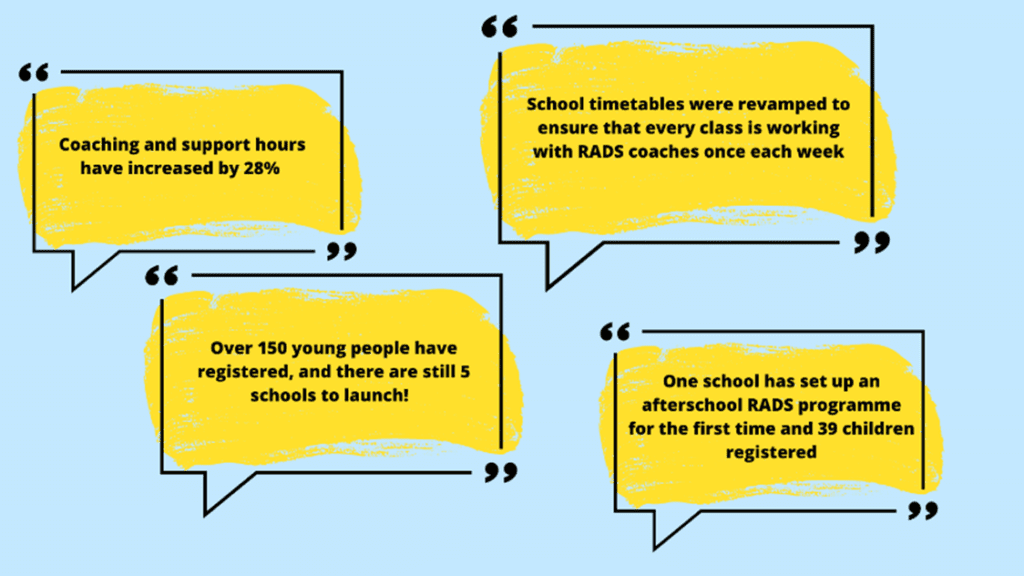
Many of these children have very little “discipline” and family guidance to attend after school clubs, RADS are delighted that they will have a purpose and a means of “getting young people off the streets” and into meaningful and impactful programmes.

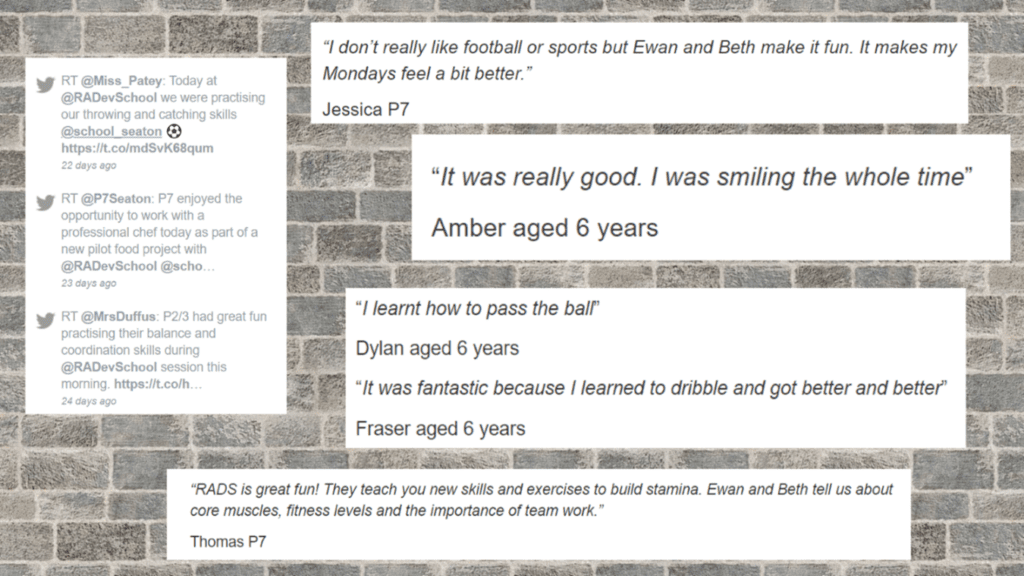

SDA consultants supported different learning styles, were mindful of differing levels of comfort and experience that the delegates had collaborating remotely. The skills, expertise and lived experience from the delegates contributed to the workshop outcomes. The collaborative processes created an environment where everyone had a role to play in innovation and improvement, a new culture that allowed people to imagine alternatives and allowed them to come to fruition.
KEY TAKEAWAYS…
…FOR PRACTITIONERS | …FOR PROVIDERS |
– Facilitating collaborative working across organisations, previously seen as ‘competitors’, helped to solidify their common goal and created a network of allies to provide support across their shared area of work. |
– Improved relationships with schools. – Gained a huge confidence boost, especially regarding creativity. – Adapting and collaborating much better as a team. – Have engaged in new partnerships
|
AUTHOR
Katie Murrie, SDA Lead Consultant
k.murrie@dundeeandangus.ac.uk
Claire Hartley, SDA Consultant
c.hartley@dundeeandangus.ac.uk
Are you motivated by the desire to make work better? Would you love to have a toolkit to help you lead the way? Well, we have some exciting news – the Service Design Academy has launched 5 new courses designed for purpose-driven people like you in the buzzing arena of Service Design.
Design skills are becoming increasingly essential for careers in any sector. No matter your role or your organisation, you can apply a human-centred design thinking approach at work. There’s something for everyone, whether you’re just hearing the term for the first time, or you’re a seasoned veteran looking to enhance your skillset.
What is Service Design?
When we started the Service Design Academy, practically every conversation started with this question. Luckily the world has changed a lot since. What hasn’t changed is our belief that service design has the potential to transform entire organisations and markets. We say that:
Service Design is the practical and creative application of design tools and methods, with the goal to develop or improve services. It is the activity of orchestrating people, infrastructure, communication, and material components of a service to create value for all stakeholders involved, build a distinctive customer experience, and maximise business potential.
Service Design is Set of Tools
Service Design gives you the tools to explore possible problems and opportunities.
Service
Design is a Process
Service Design is a
structured process that provides grip at the uncertainty and fuzziness of the
innovation process. It’s a cross-disciplinary language with
the customer at its centre, Service Design creates a silo-breaking language and
stimulates collaboration between people and departments.
Good Service Design is Inclusive Design
Design should always be judged by whether or not it achieves an inclusive environment. Design which does not do this is not good enough. Good design should reflect the diversity of people who use it and not impose barriers of any kind.
Take Care of your Employees and they’ll take Care of your Customers
The secret to employee experience is treating your employees like your best customer and giving them the same great experiences. In turn, they’re more likely to provide better customer service. Research has shown that engaged employees positively impact customer experience, and we know experience impacts engagement.
We have an excellent track record of designing courses for business. Courses can be customised and delivered privately for your organisation.
If you’re wondering if service design is the right career for you and how to get started, the first step is to consolidate your experience and build your skills. Many people come to service design with a background of different career experiences, lateral moves, even U-turns.
Ringing in the new year means new resolutions. If entering Year 3 of a pandemic has taught us nothing else, we now know that being happy at home and work is essential to our well-being.
At the Service Design Academy, we know that loving who you work with, loving your environment, being content with your financial rewards, and most importantly – loving what you do – will make your life healthier and happier. After all, many of us do spend 35 hours a week (or more!) doing our jobs, so we might as well be in love with what we do!
Making a career transition into service design can be hard. Most service designers have had to make a leap from one career path to another or from student to professional. It can be challenging and sometimes feels painful. Changing your career can take some time and there may be a few false starts until you find the right fit.
Many people come to service design with a background of different career experiences, lateral moves, even U-turns. Team members at SDA are no exception:
Katie Murrie our Lead Consultant graduated in Law from the University of Dundee, worked in the legal profession, then completed a Masters in Leadership and Innovation where she discovered her love for service design.
Kim Anderson began her career in graphic design after graduating with a degree in Computer Arts from Abertay University. It was taking part in design sprints that inspired her to learn more about design thinking and service design.
In fact, every single member of the SDA team reached service design after career experiments! If this is your story, consider yourself lucky, you will have a lot to offer and work with. If you’re considering a move to service design, think about:
· How your past has taught you many valuable skills you can bring to
the table
· Areas that excite you and that you specifically want to learn more
about/lean towards
· How you want to grow in the future

Think about new opportunities in the jobs market. It’s not that long ago that there just a handful that mentioned service design or human-centred design. Now design is EVERYWHERE – government, start-ups, charities, and the private sector. You’ve only got to search on LinkedIn or Twitter feeds to see how diverse the range of jobs currently are. And these are only the jobs that specifically mention service design, there’s a whole host more that designers/those working in a human-centred design way could fulfil, that don’t have the title.
Scottish Government statistics state that over the next 10 years the demand for service designers in Scotland will increase by 35% with an estimated 17,000 jobs available in both the public and private sector.
If you’re wondering if service design is the right career for you and how to get started, the first step is to consolidate your experience and build your skills. Here’s some tips and resources from the team at SDA.

Be confident about the skills you already possess
Don’t hide them—use them to your advantage, try to figure out how they might fit into a service design context. The holistic nature of service design means it sometimes feels like you literally need to know
everything. You might even feel a bit overwhelmed. There’s just so much info out there that you could spend all day, every day, studying and learning. If you’re spending your scarce time learning new skills, you want to know that you’re learning things that really matter and that will put you ahead in the job market.”
If you’re just reading books on service design, you’re going to miss out on some really key skills.
Becoming a service designer isn’t just about learning the tools and methods, it’s also about developing your communication, facilitation, improvisation, empathising and curiosity skills. We believe the ability to question, be curious and interrogate is as important as knowing the methods and mapping the journeys, that’s why all our courses take a learn by doing approach. They’re fun, interactive and all available to study online from anywhere.
Build a network
Building your network is important. The service design community is open and generous, make those connections and more importantly, maintain them.
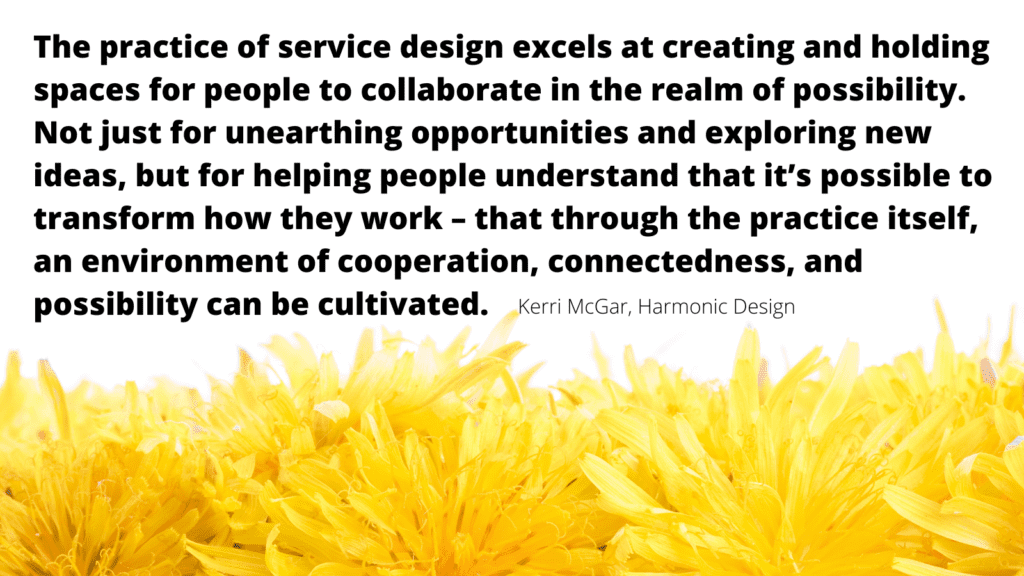
We regularly hear from alumni of our Professional Development Award in Service Design of their success stories as they develop into Service Design Practitioners.
In Spring 2022 SDA will be launching a range of short courses,
designed to support the beginning of your journey as a service
design practitioner.
· Welcome to Service Design is an introduction to the fundamentals of service design the mindset, the approach, and the principles
· Tools for Problem Solving & Innovation is a holistic approach to problem solving using tools that will enable you to drive innovation within your organisation.
· Service Design for Innovation & Impact is our flagship programme for business re-designed for those who are ready to innovate and adapt for the future using design thinking and service design methodology
We are also developing new specialist courses for Designing People Experiences and Accessible and Inclusive Design. Watch out for our next mailshot.
If you work in Scotland’s Local Authorities then our inaugural Professional Development Award in Service Design, in partnership the Scottish Digital Office, starts on 15th February 2022. Scottish Government statistics state that over the next 10 years the demand in Scotland for service designers will increase by 35% with an estimated 17,000 jobs available in both the public and private sector. Achieving a PDA in Service Design will put you ahead of the competition, and your new skills will be in demand. Check out the Heartbeat Information Pack or contact us via info@sda.ac.uk
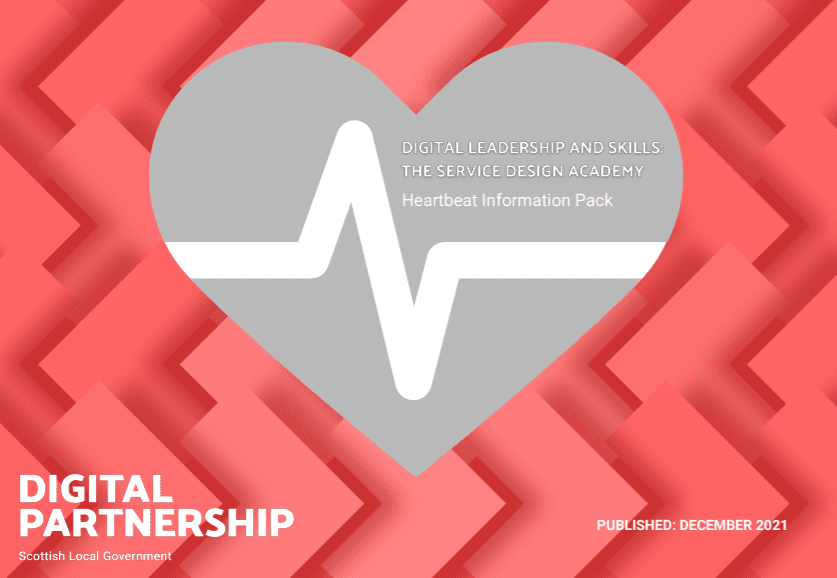
Service Design Career Articles
Below are some great articles to help you on your journey to understanding service design/becoming a service designer
Could Service Design Change Your Life?
Master your Interview Approach: A framework for Designers
Getting Connected to Service Design
Career Guides – advice and guides
To bring your service design career to the next level
Hopefully, this will help you get on your way to finding out if becoming a service designer (or hiring one) is right for you.
Sources
https://www.servicedesignjobs.com/salary-report/
https://thisisharmonic.com/service-design-career/
https://www.service-design-network.org/community-knowledge/what-is-to-be-a-service-designer
https://www.servicedesignshow.com/these-5-skills-will-make-you-a-better-service-designer/
https://www.servicedesignshow.com/how-to-kick-start-your-service-design-career/
https://thisisharmonic.com/how-to-craft-your-career-story-by-design/
Gillies need no introduction to many people in Tayside and the North-east of Scotland, as a well-respected family run furniture retail business. With a flagship branch in Broughty Ferry, they employ many loyal and long-serving staff who hold the company’s ethos of having strong customer relationships. The part Gillies plays in local communities is core to their values.
Gillies recovered after the first lockdown in 2020 with customers returning quickly to their stores. The management team had learned lessons during lockdown and had made some investment in their online presence to future proof their business,
Although Gillies have built a strong reputation on meeting high customer expectations within stores, this has been challenging to replicate online. And like many thriving organisations, improvement was needed with internal communication processes.
Gillies senior team recognised that they needed to re-design elements of their business. After speaking with Dundee and Angus College’s Skills Advisers and the Service Design Academy team, Managing Director David Philp was keen to learn how service design could be embedded as an integral part of the company’s strategy. David’s vision was to improve business performance by unlocking the creativity within Gillies teams to encourage a more collaborative culture.
Through a series of exercises in a 90-minute Discovery meeting with the Service Design Academy team in July 2021, Gillies senior management team shared what they wanted to achieve:
· To build an improved and streamlined customer journey across stores and online that is truly exceptional
· To create a cohesive, collaborative team to find solutions that are always customer focused

The Approach
From these insights, the Service Design Academy’s accredited consultants designed a customised online and interactive programme with clear learning objectives and business focused goals.
A team of 14 staff took part in six fast-paced and collaborative online workshops over six weeks. The workshops were designed to encourage creativity, guaranteeing everyone’s voice being listened to equally. The group had basic training on the online whiteboard Miro, and all accessibility needs were met to ensure a welcoming and productive environment.
The Workshops
The participants collaborated on a design challenge set by senior management –

To start, they captured and recorded knowledge and assumptions. From that teams were formed to work on different themes using a variety of tools and methods. The teams were trained in user research techniques to challenge their assumptions and fill gaps in their knowledge. Out of the workshops and back on the shop floor, they carried out in-depth user interviews (or cheerful chats) with customers. Participants learned to use empathy techniques – walking in their customers’ shoes and observing shoppers’ behaviour.
From this research activity, the teams gathered insights and then learned how to flip their problems into new opportunities. The teams used tools specially designed to encourage creativity and generate a large volume of ideas relating to these opportunities.

SDA consultants then guided the teams through the process of refining and prioritising ideas until they were left with only 3. They explored their ideas further by prototyping to testing and tweak ideas again and again through feedback and evaluation from critical friends.
The final day was devoted to planning how these new solutions could be brought to life. The teams learned to use tools to understand what every step would look like from the user’s perspective and how to create storyboards of a user interacting with the new service. To consolidate all their learning, activities and future plans, each team shared their journey through the design process and their final ideas.

The Utility Belt Tool for Implementation let the teams come to a shared understanding of how their new, or re-designed service might scale up. The tools also help them consider how to truly embed service design into the organisation.
The Outcome
Four final ideas are being taken back to the business. These cover a new customer tracking system; a blended approach to internal communications; introducing rewarding activities for staff and shaking up the induction process for new staff to ensure they truly understand the whole business, not just their role within it.


Implementation
To help build on the progress achieved in the six sessions it’s been recommended to the Gillies team to use all their golden nuggets of user research to inform the improvement of customer experience.
The management team will decide on which of the prototypes they would like to pilot, and this will be supported by the planning already done in the workshops. How the pilots land with customers will be tested using newly learned user research techniques. SDA encourages setting up a team of champions to ensure that progress is kept on track with clear guidelines on responsibility, with this new mindset of designing “with, not for” people. SDA looks forward to meeting up with the Gillies management team soon to reflect on progress and to offer support in building momentum on the change already being implemented.
Immediate Impact:
Chris Muir, SDA Consultant reflected on a successful training programme:
“The comments around the value of this training from Gillies has been extremely positive. The work produced by each of the groups was fantastic, not only in the workshop but in gap tasks. The insights and discoveries made ensured that we were indeed solving the right problems, particularly when we entered the develop and deliver phases.
There were lots of comments about building on this momentum for making changes which will ultimately result in a more focussed and better customer experience across all Gillies stores. The online workshops offered the opportunity to collaborate across different stores and demonstrated a way to capture everyone’s voice and do so in a very open and transparent way.”
On how these new skills will be used, Claire Hartley, SDA consultant added, “As service design educators, we introduced all participants to the service design mindset and showed them how all these different tools and methods can be used to facilitate conversations and capture insights.
The teams have reflected on the value from experiencing the design process and thought of many ways it will be used for being a better business, from customer satisfaction to staff engagement. However, this would not have been possible without the commitment and passion all participants gave to the challenge presented by the management team at Gillies.”
Valued Voices from Gilles
You can learn how taking a service design approach has made an impact by listening to Director David Philp and Group Store Manager Jonathan Creece here

What makes the Service Design Academy’s Professional Development Award in Service Design different?
Lack of community, low engagement and often no incentive for completion. The world of online learning is becoming stale. We’re in a post-content doldrums. In the past, educational content was valued – it was expensive and relatively scarce. It became a major selling point for universities. Today educational content is everywhere, plentiful, and much of it is cheap. Blogs, social media, newsletters, YouTube have replaced validated and reliable sources of knowledge found in the lecture theatre and library.
And that’s not all, Low cost or free online courses, incubators, accelerators, and alternative education programmes have been created to serve the lifelong learning needs of working professionals. But content profusion has created its own set of unique challenges for educators and students.
Most learners are actually worse off for all this low priced and plentiful content. More access does not equal more engagement or achievement. Take for example, MOOCs, the “Massive Open Online Courses” popularised in the 2010s, with a completion rate of just 3 to 6 percent.

At the Service Design Academy, we believe cohort-based learning holds the key to impactful learning. They are interactive, community-centric, remotely delivered online courses where a group of students advance through the materials together – with hands-on, feedback-based learning at the core.
What makes our courses unique?
They are engaging, real-time, and involve community-driven, active learning as opposed to solo, passive content consumption. Fixed start and end dates ensure a real-time and paced experience. Mentoring making for an authentic, personalised approach even the smartest of online content – with machine learning and algorithms – can’t match.
Scarcity drives value. In today’s content-rich world, what scarce is community . Cohort-based courses provide community and so much more.
A great course is a catalyst for transformation. Before we created our first lesson, we identified what the transformation would be. We thought about what our students can do after taking the course that they couldn’t do before. We explored the structure of the course. We wrote compelling learning objectives and explored different curriculum formats with real world examples to make the most sense of our students.

Online learning has defaulted to on-demand video where viewers watch experts share information. Our cohort-driven courses introduce fundamental learning principles through active learning. Using the tools of service design on live business challenges, we’ve a complete toolkit to cover the subject. We’ll show and share how and when to use these tools so you can immediately use them in your professional context. From break out discussions to case studies you’ll join a community of like-minded people seeking a similar outcome.
We call it “learn by doing” – active learning, not passive watching, every workshop is designed to help you put your learning into practice.
Expert, passionate, and accredited staff will keep you engaged and help get you make sense of the process and the theory.
And we do recognise the value of online resources but only when they are offered in the context to our interactive remote learning. Learners benefit from our signposting to a resource of validated, trusted online learning material including Storytelling videos.
Are we a course creator with a trusted voice in the service design space?
Absolutely. Our course became the first and only, service design qualification accredited the Scottish Qualifications Authority. In 2020, The Service Design Academy became the first organisation in the world to receive the Service Design Network’s Organisational Accreditation following a rigorous and in-depth audit. Through this initiative, the SDN has recognised the authority and quality of SDA in the provision of service design education and qualifications. You’ll receive certification from SDA and SDN. We were shortlisted in the Top 3 of the Digital Leaders 100 Awards 2021 in the Public Service Innovation of the Year category for the approach we took to designing our online learning with our students and not just for them.
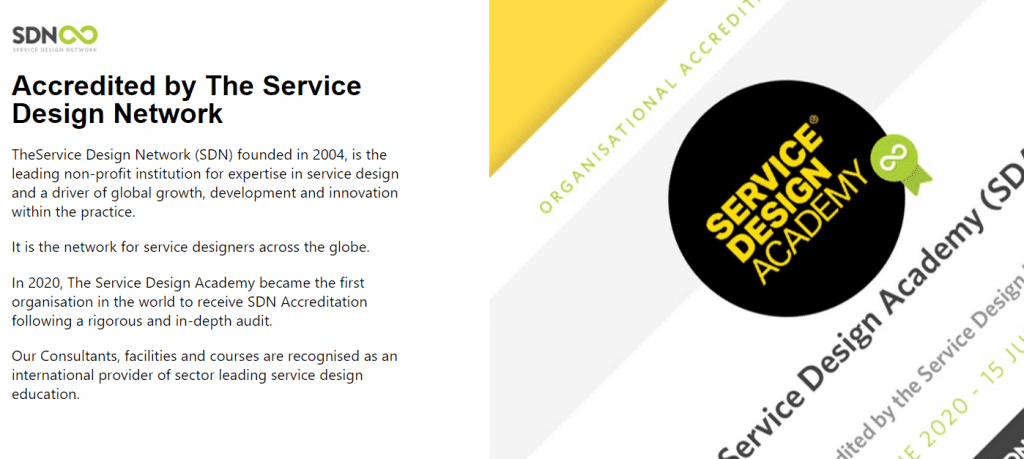
Is the course taught exclusively by us or by a collective?
We are not an Agency who provides training, we are educators pure and simple. The recent influx of independent course creators means these new teachers may have practical experience but less theoretical knowledge. We have achieved mastery in our skills in service design, in facilitation and in teaching. Four members of our team are SDN Accredited Practitioners, and our Lead Consultant is an Accredited Master Trainer who sits on the SDN Accreditation Panel. Our Team Bios show the range of our expertise and achievements. Our Newsroom shares stories of our successes so far both in terms of the individual achievement of our PDA in Service Design graduates and alumni our work in building service design skills and capacities in organisations.
We’re backed by Dundee & Angus College’s well-developed reflection and self-evaluation arrangements which enables review and any necessary action and improvement to take place timeously. Themes and priorities for consideration link into the Quality Themes and Indicators outlined within the Education Scotland How Good is Our College framework, and to the Professional Standards for Lectures in Scotland’s Colleges.
A team of Learning and Teaching mentors within our Academic Development team support academic staff through teaching qualifications. They promote the sharing and enhancement of practice through a flexible model for observation which supports and encourages innovation.
We’re very social
Social interaction is right at the heart of what we do. We want to put an end to the loneliness of the long-distance learner. That’s why, throughout our course, you’ll find discussion steps and chances to debate and interact with other learners. That way everyone learns from each other, discovering new perspectives and forming new ideas.
We love service design
For us, service design is not just another discipline – it’s in our DNA. We believe the ability to question, be curious & interrogate are as important as knowing the methods & mapping the journeys.
SDA Insights Vol 7 focuses on the Service Design Global Conference which took place on Thursday 21 & Friday 22 October. The newest member of our team, Robbie Beautyman, was a SDGC Conference newbie. We asked him about his favourite talks, key takeaways, and personal impressions of this year’s event.
I found the SDN Global Conference to be an amazing experience on many different levels. It was great to be surrounded by hundreds of like-minded individuals – albeit virtually. You could feel a sense of camaraderie in the air between the speakers, MC’s and attendees in the chat function which is no mean feat to achieve online.”
Cat Drew, Chief Design Officer at Design Council kicked off the event. Cat’s role brings together architecture and the built environment, public sector design and business innovation to support people live healthier, happier lives.
Cat’s keynote was a real highlight for me. It set the tone for the rest of the conference. I particularly enjoyed the section around using trees as infrastructure, including them as main stakeholders within cities alongside humans, especially her example of Melbourne giving 70,000 trees identification numbers to enable citizens to email them (and receive replies!).”
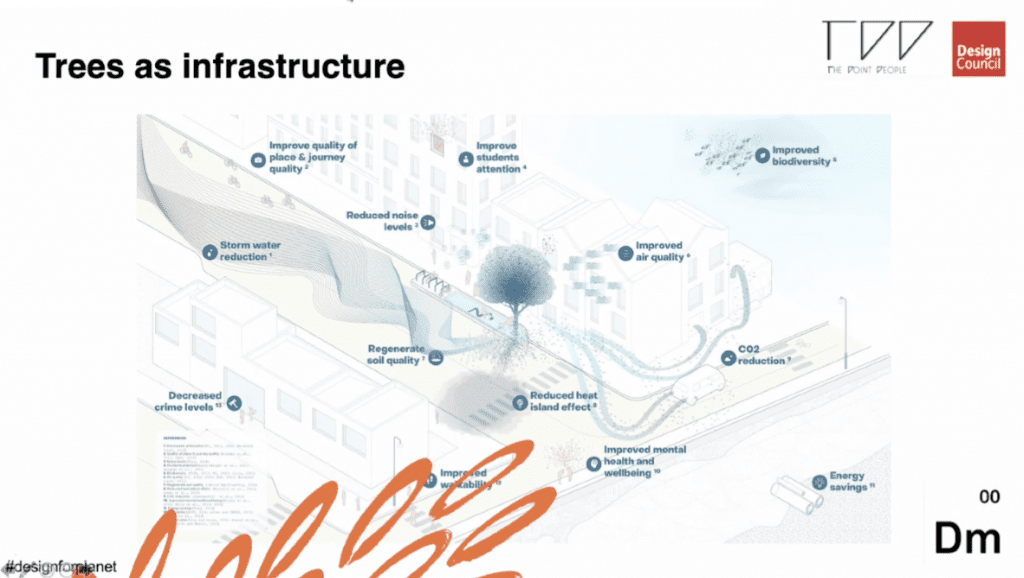
Cat insisted that service design can have a positive impact on the planet if we start to bring the planet to the table as a main stakeholder. The numerous examples, data and insights from across the world included in Cat’s talk was phenomenal! From the caulibox takeaway containers to recycled industry material slow fashion bags.
“If you aren’t designing for the planet, what planet are you on?”
I tuned in to Florie Remond’s talk – Planet Centred Service Design. Florie works to raise awareness of eco-design in the field of services and helps companies to align their strategy and their services with their values and those of their customers.
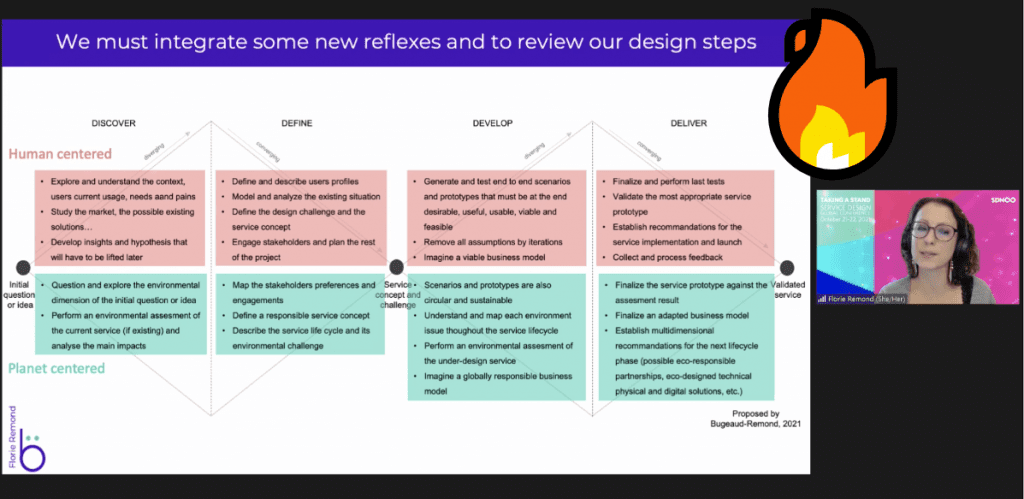
Next up I joined Zeynep Falay von Flittner’s workshop. Zeynep discussed changes organisations need to make when transforming towards sustainability, arguing that organisations can no longer rely on good customer experience, now it’s more than that, sustainability is important, and we must stop thinking about the planet as an external factor and start thinking about the human/planet relationship.
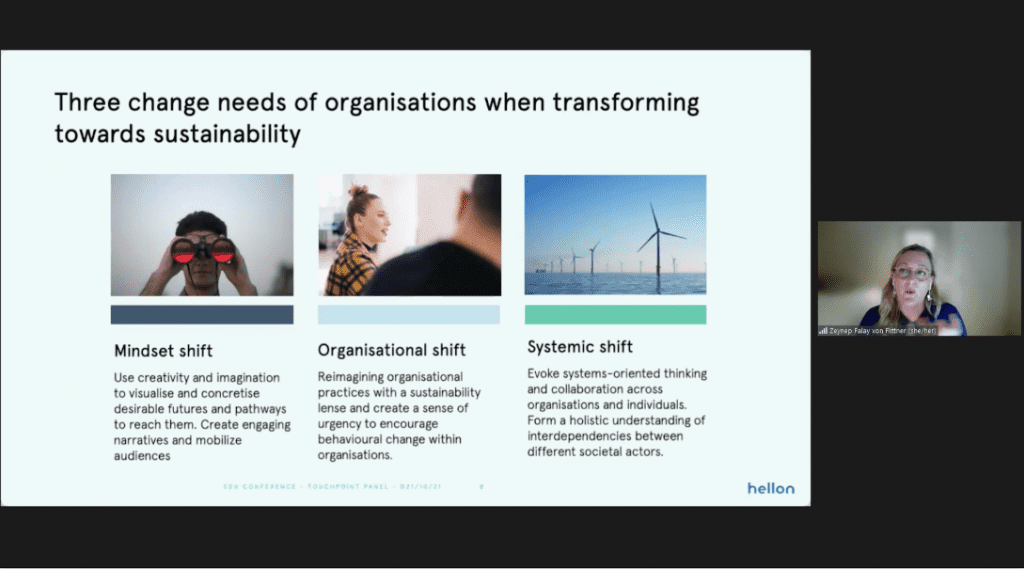
Key Takeaways
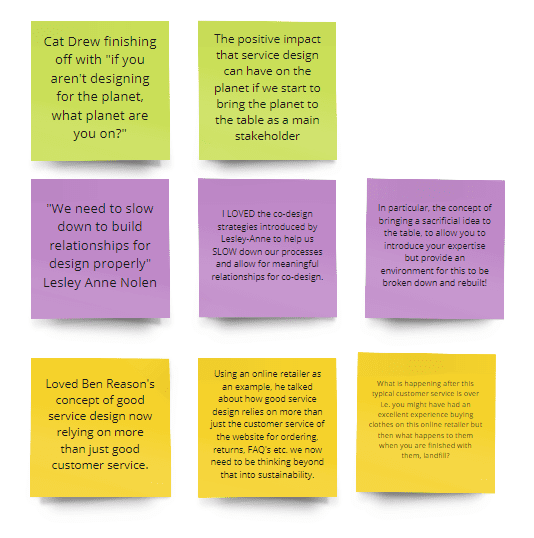
Overall Impressions
I first thought 20-minute talks would be the perfect length; enough time to get the speaker’s point across but not too long to lose attention. The latter was true, but this top-level approach often left me hanging, wishing there was more in-depth information about the speaker’s research. The fact that I was left wanting more meant I was then inclined to go away and do my own research on the topic, so in this respect, these ‘taster sessions’ into each topic served their purpose very well.
The conference was very well facilitated on Brella. As an attendee, I found it very easy to navigate and thought the chat and poll functions were very useful. The ability to upvote other attendee’s questions during Q&A sessions was a great feature too. Since there were people with such a wide variety of experience streaming the conference, they often asked questions I would not have thought of personally but was still interested to hear the answer to.”
Design Council: Design for Plant, 10th & 11th November 2021
A landmark festival to galvanise and support the UK’s design industry t commit to a sustainable, climate-first future. This 2-day event will give a platform for visionaries across the sector who are leading the way in sustainability and climate action and will support others in the industry to prioritise the welfare of our plant in their work.
https://www.designforplanet.org/
SDA’s Professional Development Award in Service Design
Applications are open for our PDA in Service Design starting in January 2022. We’re created a short overview video that talks you through. If you’d like to talk to one of our Consultants about any aspect of the study, use our Contact Form or call us on 01382 448868. Delegates from a huge range of backgrounds have successfully completed the Award.
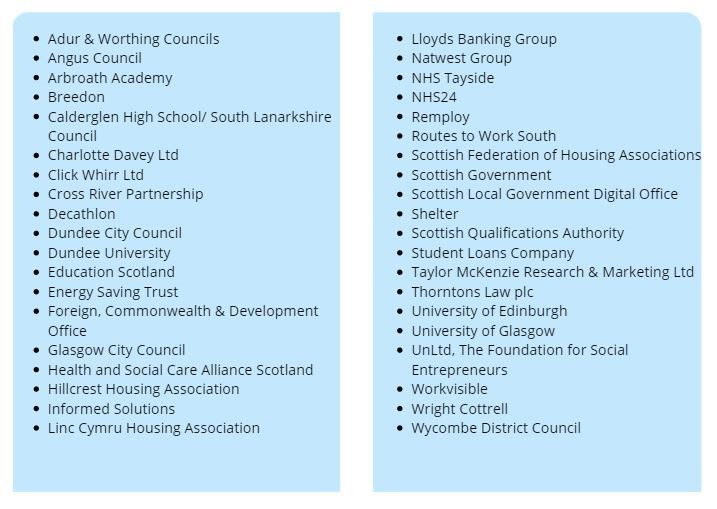
Kevin Meehan recently completed our Professional Development Award in Service Design, a 6 month course that covers the core skills, tools and mindsets you need to service design powerful interventions for complex issues.
It was great to hear from Kevin last week about how his learning has benefited him and the student loans company he works for.
“Since completing the course, and implementing the techniques and methods learned I have managed to secure a new role within the company as a UX designer.”
Kevin also said;
“This wouldn’t have been possible without access to the PDA, so thanks to all at SDA, but especially Chris and Claire for all the help and guidance provided.”
We’re so glad to hear that our PDA helped Kevin secure his new role within the business, and wish him every success.
If you have a service design success story please share your good news.
An upcoming event worth planning for
Service Design Network Virtual Global Conference Join us on October the 21st – 22nd, 2021 in Taking a Stand to impact our organisations and our communities so that we may co-create a better tomorrow.
Vote for Us!
The Service Design Academy is thrilled to be a finalist in the Digital Leaders 100 Awards in the Digital Public Service Innovations of the Year category! This recognises how we redesigned our online learning with our learners, customers partners and friends.
We’d love this wonderful collaboration to be celebrated – so please do take 20 seconds to vote for Dundee and Angus College “Service Designing Online Learning” here.
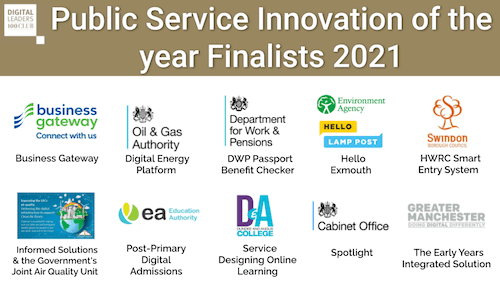
In advance of National Customer Service Week, we reflect on how expectations are rising, and business transformation needs service design to keep up.
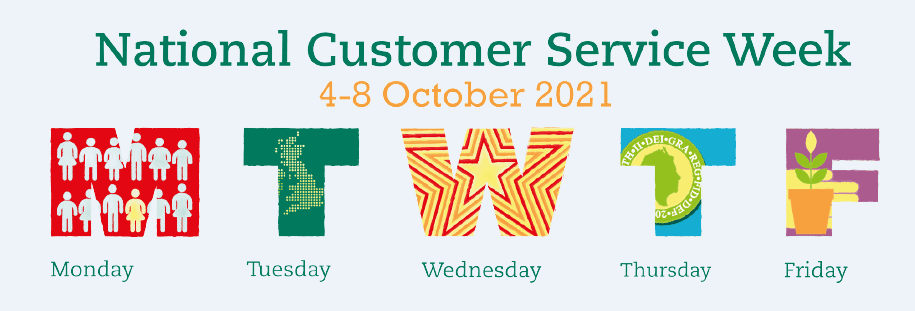
The Covid-19 crisis is not over, and the longer-term societal and economic impacts are not yet fully known and understood but they will shape the future business landscape. This is a critical time to take stock of lessons learned and to re-imagine and re-design future priorities.
The UK Customer Service Index Report launched in July shows a slight improvement in overall customer satisfaction, although some improvement can perhaps be credited to better complaint handling and service recovery. Record numbers of customers have experienced a problem with an organisation. What this demonstrates is that businesses have adapted to become better at dealing with issues but not necessarily better at preventing complaints in the first place.
Customers have appreciated improvements or innovation in services such as
When Covid hit, it was inevitable that service levels would fall while companies readjusted and established teams working from remote locations. Wait times lengthened, processes were unclear, and the sharpness of businesses became blurred, but three quarters of customers expected this.
Almost 18 months later, Covid-19 cannot be used exclusively as an excuse for poor service. Expectations rise, and the best businesses transform themselves to keep up.
Covid has heightened the importance of flexibility, adaptability, and innovation. Organisations need to learn from the enforced changes of Covid-19, retain the benefits and develop the mindset and capabilities to enable ongoing innovation.
More customers have made online purchases or chose to buy from local or ethical suppliers, and the number of customers who are willing to pay more for excellent service has grown to almost 32%.

In addition to these statistics, the value of listening and learning from user experiences has strengthened our understanding of the contribution of customer service to well-being, quality of life, trust in organisations, and business performance. A sustained focus on customer experience will be vital for the health and prosperity of the organisations, their customers and employees, and our economy.
The problem with thinking about customer experience without service design is it risks creating gaps in the delivery and maintenance of services and products. Unless your organisation is set up and working to deliver a consistently great experience for all customers, problems will float to the surface, with inconsistencies and customer frustration from unintended consequences.
In large organisations there will be multiple teams responsible for designing and delivering what in the end should feel to the customer like a unified experience. Service Design as a practice ensures the customer experience is unified, and that the organisation can deliver it. Unified customer experiences are also critical for small businesses who can’t afford to take costly risks when innovating.
For any organisation, Service Design should be your first port of call when designing new processes or rethinking entire ways of doing things; more now than perhaps ever before.
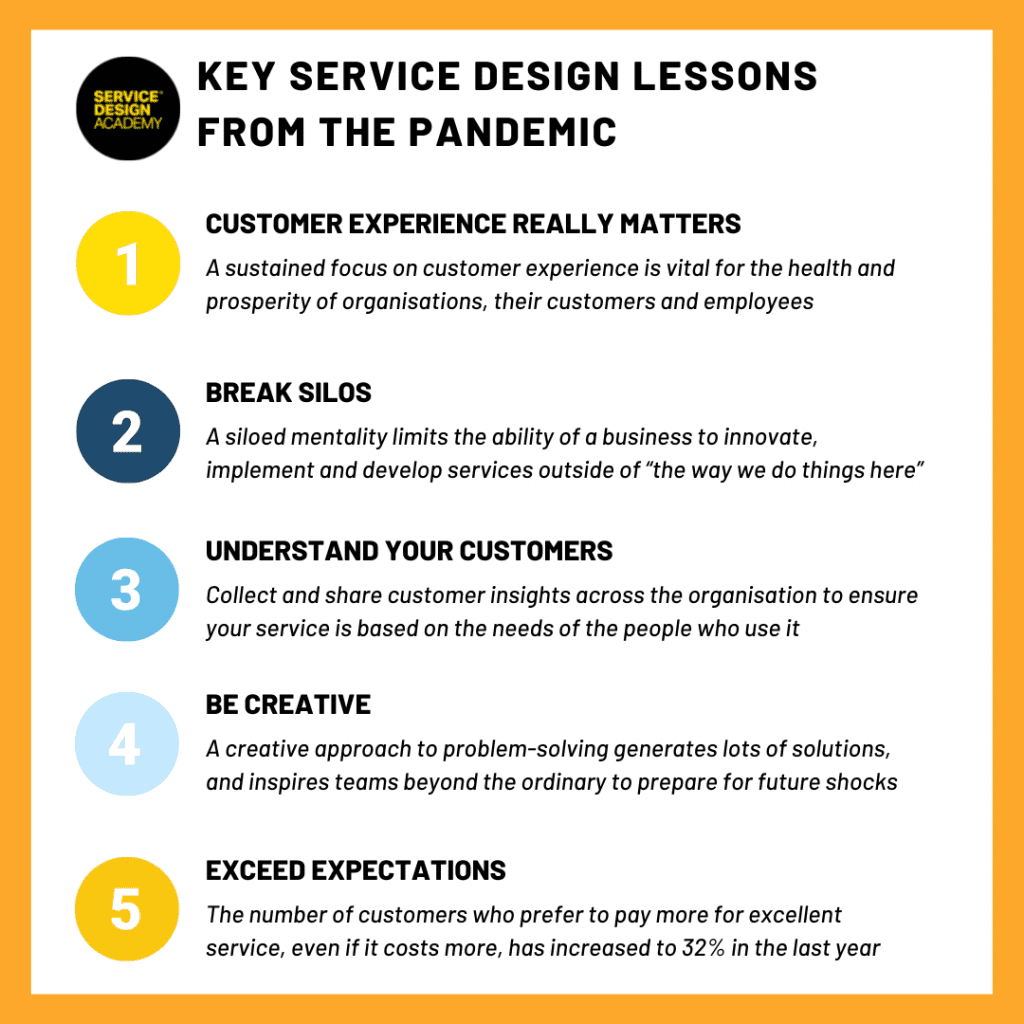
We’d love to hear what you have learned about customer service in the past 18 months, as a customer or as you deliver a service. To start the conversations, we’ll see you over on social media.
References
Great short reads
Measuring the value of service transformation
Global events, research and technology company GDS collaborated with individual service teams in several government organisations to identify and document the value of their digital transformation work. This blog post marks the start of a series, which aims to document these examples and case studies of best practice and good end-to-end service design.
https://services.blog.gov.uk/2020/04/14/measuring-the-value-of-service-transformation/
The Power Of Branding
The design Council has created this guide to shed some light about branding: what is it, how it works and how you can use it to help improve your business or the perception of your service.
Events worth planning for
National Customer Service Week (NCSW) Is fast approaching! From Monday 4th of October ICS will be celebrating customer service in organisations with a series of themes. They have prepared activities for each day, in addition to some helpful resources.
Service Design Network Virtual Global Conference Join us on October the 21st – 22nd, 2021 in Taking a Stand to impact our organisations and our communities so that we may co-create a better tomorrow.
Please Vote for Us!
The Service Design Academy is thrilled to be a finalist in the Digital Leaders 100 Awards in the Digital Public Service Innovations of the Year category! This recognises how we redesigned our online learning with our learners, customers partners and friends.
We’d love this wonderful collaboration to be celebrated – so please do take 20 seconds to vote for Dundee and Angus College “Service Designing Online Learning” here.

As always, we’d love to hear if:
Use the link https://www.sda.ac.uk/contact/ or email info@sda.ac.uk
This is late! We missed our June edition, things were busy, staff were getting ready for holidays. I remember when we used to say ‘winding down’ for the holidays but that just doesn’t seem to be the case anymore! Enough of the excuses, we’re back with some great insights, articles and events that are on the horizon.
No Boundaries, No Limits
Maralyn, our Business Development Executive talks every day with SDA customers, about the benefits of taking our accredited Professional Development Award. She shares the value of the course based on speaking to SDA Consultant, looking at course content and reading students’ stories and hearing their feedback. In April it was time to move from secondary research to experience the course first-hand. What’s the Professional Development Award with the Service Design Academy really like?
Maralyn is halfway through the 4-unit, six-month course. We asked her to share her perspective; someone with no service design experience who has returned to the classroom for the first time in a very long while!
Make the learning work for you
This was a different learning experience for me. Rather than the standard expectation I had from training – at best, giving things a go between chalk and talk – we’ve been taken through service design theory to set the context, then quickly on to tackle design challenges together.
Out of the classroom, the four assessments require a focus on work-based issues that will enhance my learning experience and be worthwhile for my organisation. If like me, you don’t design services as part of your everyday role, start thinking about issues that would benefit from your intervention. You’ll need to ask managers and colleagues for their time and support. By helping them understand your goals, you’ll gain buy-in from the beginning for you to learn while making a difference at work.
Pace Yourself
“Don’t leave your assessments to the last minute”, said SDA consultants Katie and Kim in our first introductory coffee shop. Did I listen? Of course not. However, I’ve learned to commit chunks of time during of time during the week, evenings, and weekends to avoid a mad dash on deadline.
All the planning and preparation you need is worth it. My visual portfolio will be a living document that will support my work, not a lifeless essay gathering dust at the back of the wardrobe. Your portfolio will become a tool to share your design progress with others, so it needs love, time and attention.

Small is beautiful
I had an idea of a work project that I’d like to use as my Tools and Methods assessment and had some great conversations with Katie about how to facilitate a small event with the team and with a customer. However, I did not plan the time well, it took much longer than I expected to get through the exercises. The insights I gathered were very useful to inform our customer journey, but I’ve learned to rein in ambition on getting lots done in one session. That’s all part of the service design mindset, progress is incremental and iterative.
Give, Take and Ask for Help
I was assigned a buddy for each unit. Buddies team up in the coffee shops, it’s a great way of sharing concerns, gaining clarity on the coursework, and getting reassurance if you’re having a wobble. I use the dedicated teams channel for my cohort to talk about problems I’m experiencing or material I don’t understand. It’s always helpful to hear from others about their progress.
The consultants share industry articles regularly to build our knowledge and understanding. Every PDA delegate gets free professional membership to the Service Design Network, which means access to a global community of practitioners, and many benefits including Touchpoint magazine and a wealth of case studies which have proven to be very useful for assessments. Service Design has a naturally sharing culture and this makes you feel a part of it.


No boundaries, no limits
I’ve been guided by the service design mindset throughout the course. Planning user research – why not ask someone to look over it as your critical friend? Being clear on the purpose of what I’m doing, and how to share effectively with others is developing my communication skills. I’ve realised that the principles for ideation or co-design aren’t a checklist for how I should behave in a workshop. They guide how I want to work, and how I’ll approach engagement and building relationships. In over 20 years in sales and marketing, I’ve always tried to put the customer first. Service Design is helping me do this the right way.
Great short reads
Events worth planning for


Rory, SDA Social Media and Marketing Assistant has been sharing the value of Service Design Academy’s programmes since April. To understand more about service design, he’s been observing our PDA learning labs. When the chance came up for a hands on experience in our 2-day Tools for Problem Solving & Innovation course in early June, he jumped at the chance. In addition to building awareness of service design first- hand, he was excited to gain new skills to co-design marketing campaigns with the team. He shares his story here.
I attended the SDA Tools for Problem Solving & Innovation course in early June delivered by SDA consultants Chris Muir and Claire Hartley . They were both excellent at keeping us engaged and conveying information in a way that sunk in. Which was great as although I work for the SDA, I’m still quite new and don’t have a deep grasp on everything Service Design yet. Let me break down what happened and what I learned over the 2-day course.
Day 1: Love The Problem
As you might expect, at the start of Day 1 there were some fun ‘icebreakers’, a nice way to relax us into the main activity ahead.
We started by thinking about 4 typical work issues everyone could be familiar with ‘Leadership’, ‘Silos’, ‘Conflicting Priorities, and ‘High turnover’
We worked together to uncover key themes behind these issues – ‘Conflict’ ‘Us and them’, ‘Emotions’ and ‘Communications’. With a technique described as affinity mapping, we formed groups to work on a chosen theme.

My team researched current day problems relating to our theme. Then we collated the data we found by using a ‘Problem Framer’. Before we reached for a solution we first needed to properly frame the problem, in this case our problem was “Loneliness Due To Covid”. These “discover and define” phases of the process that Chris and Claire shared with us was a complete flip in mindset for me. I like to think quickly about solutions to any problems, but this tool helped us really dig deep into understanding more about the issue. As Claire said, we need to love the problem first!

A jam-packed day was drawing to an end. I’m sure the rest of our group felt as buzzed as me, we were all quite talkative and responsive when we were having group conversations throughout the day.
Day 2: Flower Power and Prototyping
Chris and Claire started by explaining that we were moving into the develop phase of the design process, it was time to start ideating. Claire showed us how to use our next tool, SDA Sunflowers. It’s a simple tool which helps you start with an initial idea and develop more ideas around them. This was a fast-paced exercise – filling up the idea petals in one sunflower before expanding on more ideas to how to make this idea happen. With 8 idea petals on each sunflower, and 8 sunflowers we could have come up with 64 ideas, a daunting but exciting and fun challenge for my group. Chris helped us by explaining that it was better to focus on our preferred ideas and then work on those ones.
Next we had to bring forward our favourite solution and prototype how it would work, we chose:
Walking Group – “Themed walks for where ever you are! In the countryside? You can do some birdwatching! In the city? You can do some sightseeing!”

I drew a sketch of the different routes that could be taken and the kind of activities you can have during the walk, I love drawing, so this was a pleasure for me. Service Design builds confidence in everyone to use visualisation to get ideas across to people you are designing with.

To round off a very busy 2 days, all the teams gave 3 minute presentations to share their prototypes.
Time always flies when presenting, and we overcame our nerves to do a great job! We enjoyed the other teams’ presentations, it was good to hear feedback from them and the consultants.

Summary
The course was very enjoyable, Chris and Claire were great at keeping it engaging. The tools really made me think and work through a problem with others in ways I haven’t done before, I certainly wasn’t taught like this in school! It was easy to collaborate online and I’m happy I was able to further my knowledge on Service Design.
For those interested in looking at our courses, there’s a link to the courses page below!
© 2020 Service Design Academy
Made with ❤ by mtc.